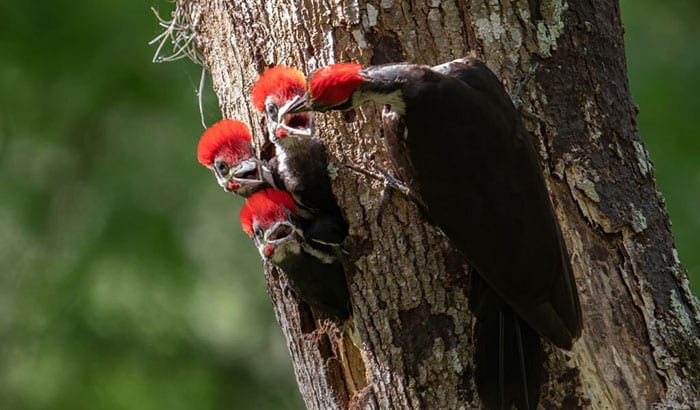Just like any other birds, woodpeckers also come with unique traits. Their ability to peck on woods or trees makes them very different from other birds. The constant pecking comes with various purposes but can also damage a tree.
But the question is, can woodpeckers kill a tree? Absolutely not. Yes, woodpeckers can bring minor damage to trees by making holes in them. However, this unique trait of woodpeckers is also essential in keeping the forest healthy.
Contents
Woodpeckers Bring Minor Damage to a Tree
Different woodpeckers bring damage to trees by creating holes vertically or horizontally. However, these woodpeckers only come into a tree for various reasons and killing the tree is not one of them.
Yes, they can bring minor damage to the tree, but it is not them who will cause the tree to eventually die but other environmental factors. Generally, a healthy tree can withstand any damage that woodpeckers bring.
It is also important to note that these birds prefer to visit and peck dead trees for hunting and nesting. They will also consider when the heartwood or the dense inner part of the tree trunk is already rotting. This situation will allow the birds to nest.
To conclude, those small woodpecker holes made by woodpeckers will bring minimal damage to large trees. This damage is minor and will not have any damaging effects on the tree to kill it eventually.
Sapsucker Can Kill a Tree – But It’s Rare
Do woodpeckers kill trees? The sapsucker is a variety of woodpeckers that has the ability to kill a tree. But this situation rarely happens unless the trunks or the limbs of the tree have already received injuries. Sapsuckers usually build the holes in trees in vertical or horizontal form. These birds will look for sap and insects trapped in the sap for food.
Unfortunately, sapsuckers will return to the same tree, causing severe damage to the tree. The holes made by the sapsucker are small, but there will be plenty of them. And this type of woodpecker likes trees with thin bark to create more significant damage.
It is also nice to know that yellow-bellied sapsuckers are migratory birds. It is expected that the birds will come starting in October until April. So, it is normal during late winter or early spring when people notice the damage brought by sapsuckers.
These woodpeckers holes made by sapsuckers will not significantly impact large trees. However, when these birds feed on smaller trees and create a number of holes, it can potentially bring significant damage and possibly kill the smaller tree. But then again, this situation happens rarely.
Woodpecker Pecks a Tree Not to Kill It
To understand this unique trait of woodpeckers, you must know why it is constantly pecking at trees. If you are not aware, you may think that a woodpecker is banging their face on a tree as hard as they are doing self-mutilation. However, this behavior is based on other reasons:
Communication
Instead of tweeting as the other birds do, woodpeckers will drum on the trees to make a tapping sound. The sounds produced will be their way of communicating with their rivals while scaring possible predators along the way.
The sound produced also makes communication with other birds. It will be used to attract mates specifically. You should know that the woodpecker is shy and does not tweet like the other birds. The drumming of the trees is their way of communicating with other birds.
Nesting
Woodpeckers also peck on trees to build their nests. While other birds will look for twigs and grass in building their nest, the woodpecker does it differently. The woodpeckers use their carving ability by pecking on the wood until it makes a hole in the tree structure to build the nest.
When you see a woodpecker building a larger hole, it is an excellent indicator that the bird is building their own nest. But if you see the bird making smaller holes, it is probably because they are looking for food.
Feeding
When an old or damaged tree is full of insects, this tree will likely die sooner with the infestation. The insects will eat all the healthy parts of the tree, causing the tree to die eventually. This situation is the perfect opportunity for the birds to eat these insects.
In addition, the woodpecker will also cut the bark of the tree while making a hole in the wood. The woodpecker is doing it to look for bugs or other insects inside the wood. Please note that the woodpecker is only present in the wood because of the presence of their prospective food. The dying trees are caused by other factors, such as the damage brought by the insects.
Woodpeckers are Natural Peckers
Woodpeckers peck on trees because they can. In fact, not all birds can do the pecking behavior as woodpeckers do. Woodpeckers are built with solid beaks and necks, which allows them to peck on wood non-stop without hurting themselves.
It is said that woodpeckers can peck 10000 times a day. The neck has a natural absorbent property to balance the vibration while avoiding concussions. Woodpeckers also use their pecking ability to mark their territories.
Woodpeckers will peck on woods loudly to let other birds know of their presence in their territory. But this pecking behavior also damages trees and other industrial structures and buildings. This behavior is a survival tactic to guarantee and protect their well-being.
Conclusion
Can woodpeckers kill a tree? The constant pecking of woodpeckers to large trees brings only minor damage and will not keep it. A sapsucker is a variety of woodpeckers which can kill a tree, but it rarely happens.
A woodpecker may bring damage to a tree or a structure, but all of these actions are purely unintentional. These birds are equipped with their natural pecking ability for survival and protection.

